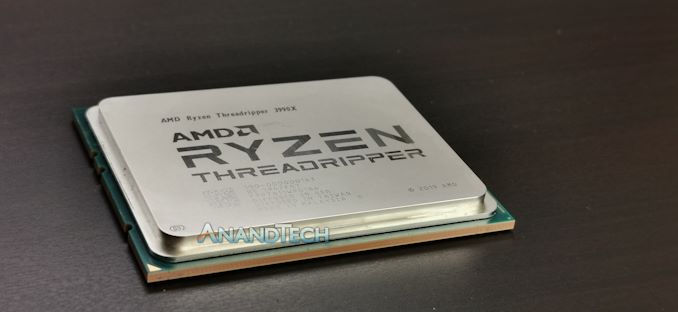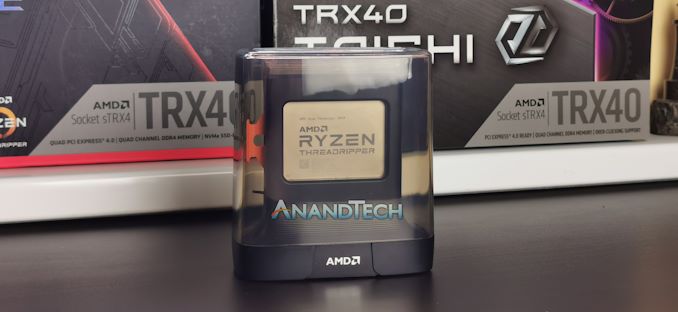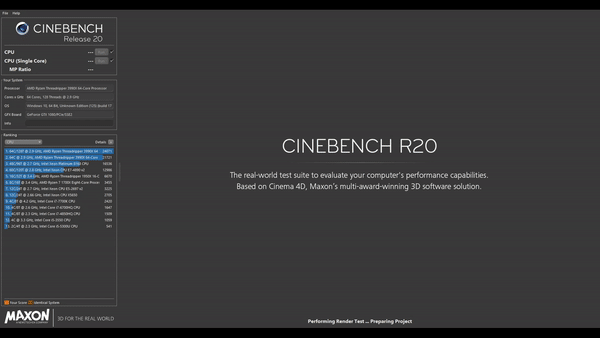The 64 Core Threadripper 3990X CPU Review: In The Midst Of Chaos, AMD Seeks Opportunity
by Dr. Ian Cutress & Gavin Bonshor on February 7, 2020 9:00 AM ESTConclusions
The art to building a good CPU is balance: you want something that is fast for individual streams of instructions and data, but also fast for multiple streams. You need something that is also power efficient, high yielding, and can be put together quite easily, with software out there already able to take advantage of what you have made.
“Opportunities multiply as they are seized.”
AMD has succeeded at a time when its competitor has struggled. As AMD launched its Zen 2 hardware across its Ryzen and EPYC product lines, built on TSMC’s 7nm, Dr. Lisa Su the CEO stated in interviews to AnandTech that:
‘We've executed our roadmap from the previous five years and we’re extending it into the next 5 years, all while assuming our competition will be competitive and even beating their public targets.’
At a time when Intel is struggling with its 10nm manufacturing process, AMD is targeting where Intel should have been if it had executed to time. The fact that Intel has suffered issues has benefited AMD, with its latest Ryzen and EPYC CPUs taking high praise. The follow on from these has been Threadripper, and the first two Zen 2 based Threadripper CPUs were quite good. I even used the word ‘bloodbath’ in the review, it was that impressive compared to what Intel had to offer.
Read our Initial Threadripper 3000 Series Review Here
With this third Threadripper 3000 processor, the 3990X, AMD is hoping to capitalize on its successes. The concept here is relatively simple: more of the same. Double the high-performance Zen 2 cores, at only slightly lower frequencies per core, for the same power – if a user has the right workload, then it’s the ideal processor.
And there-in likes the crux of this CPU; what is the right workload?
“Know yourself and you will win all battles”
One of the continual talking points about new CPUs is if the ecosystem is ready for them, especially with AMD pushing core counts ever higher. There’s no point having a million cores if everything is written for a few cores – not everyone runs a thousand copies of the same workload at the same time. Unfortunately this is what happened here with the 3990X. We’re in a situation where only a few software packages (that we tested) work great with the CPU, but it’s also the operating system that’s behind.
In our reviews, I prefer Windows for both comfort but also because a lot of the user base is on Windows. We typically use Windows 10 Pro, but because this CPU has 128 total threads, the regular version of Windows 10 Pro has issues – we had to move to Windows 10 Enterprise in order to see a difference. The alternative was to disable simultaneous multithreading, taking us back to one thread per core, which actually worked really well for a lot of tests, but also left some performance on the table. We suggest that 3990X users who typically have Windows 10 Pro do one of these two things: either disable SMT or use Win10 Pro for Workstations/Enterprise. This issue is down to how Windows tracks processor groups, an adage from multi-socket platforms, which shouldn’t apply here but because it’s hard coded into the OS when we have above 64 threads, it’s a pain.
Then there’s also the workload issue: we saw a number of tests, like Corona, Blender, and even NAMD, work great, which points to rendering and scientific compute benefiting from such a high core count processor. However other programs, such as 7-zip, LuxMark, Photoscan, and others did not see much (if any) of an improvement in performance compared to AMD’s own 32-core CPU.
I’ve heard a lot of silicon engineers say that adding cores helps, but adding frequency helps everything. The question then becomes whether you target workloads that can scale out (more cores) best, or whether scaling up (more frequency) is a better solution. We either end up with target CPUs for one or the other, or a combination CPU that tries to do both.
“[He] who wishes to fight must first count the cost”
In this review we evaluated two directions for AMD’s 64-core 3990X. The first was at the consumer/prosumer level, looking up to improve on their high-end desktop system. The second was at the enterprise level, looking down to see if that single 64-core CPU is actually worth it compared to a dual socket system. The conclusion might shock you. (It might not.)
For the first stage, the consumer/prosumer level, our conclusion is that the usefulness of the 3990X is limited. Aside from a few select instances (as mentioned, Corona, Blender, NAMD) the 32-core Threadripper for half the price performed on par or with margin. For this market, saving that $2000 between the 64-core and the 32-core can easily net another RTX 2080 Ti for GPU acceleration, and this would probably be the preferred option. Unless you run those specific tests (or ones like it), then go for the 32 core and spend the money elsewhere. Aside from the core count there is little to differentiate the two parts.
The second stage, the enterprise level, it becomes a no brainer to consolidate a dual socket system into a single AMD CPU – the initial outlay cost is substantially lower, and the long term power costs also come into play. This is what the enterprise likes to combine into ‘Total Cost of Ownership’, or TCO. The TCO and performance advantage of AMD here is plain to see in the benchmarks and the pricing. The situation gets a little muddier when we compare which AMD CPU to choose from: typically a server market wants RDIMM memory, which only comes from the EPYC processors. The difference between the 64-core EPYC 7702P and Threadripper 3990X is minor in terms of cost (under $500), and each CPU has its benefits: EPYC gets more PCIe lanes (128 vs 64) and more memory (8 channel RDIMM vs 4 channel UDIMM), while Threadripper gets better frequencies (2900/4300 vs 2000/3350) for a higher TDP (280W vs 200W). From a server perspective, if you need more IO or more memory, get the EPYC, otherwise Threadripper merits consideration.
“Do many calculations [to] lead to victory”
In the end, the situation for the 3990X is not as clear as it was with the 3970X. It’s a good chip, but it’s not the best chip for everything. I will tell you what it is good at though: ever seen Cinebench R20 complete in 16 seconds? Here you go:
A final thought. The AMD TR 3990X is amusingly priced at $3990. It’s a great marketing idea, and gets people talking. I’m proud to say that this price was my idea – AMD originally had it for something different. I don’t often influence change in the industry in such an obvious way, but this one was fun.
True story: the $3990 price tag on the 3990X is @IanCutress's doing. https://t.co/7CpuwubS6L
— Ryan Smith (@RyanSmithAT) January 6, 2020














279 Comments
View All Comments
darealist - Saturday, February 8, 2020 - link
$4000 to ripoff their loyal fanbase. All the shillz be liek "it's a steal!" while typing on their 1600x build ROFL.levizx - Saturday, February 8, 2020 - link
what a stupid dipshitSpunjji - Monday, February 10, 2020 - link
*facepalm*It *is* a steal - for a 64 core CPU.
I can't afford one, I'd never have any use for one, and I don't think anyone who qualifies as AMD's "loyal fanbase" would either. It's basically an industrial tool - the people who need this will buy it based on that need.
StuntFriar - Saturday, February 8, 2020 - link
While it's a little specific, it would be cool to benchmark some Unreal Engine 4 game developer workflows, such as doing a full rebuild/repackage of a game (for Windows, Android, iOS and consoles), rebaking the lighting for a level, importing assets, etc...I'm suggesting UE4 because Epic already has a bunch of freely available demo projects (some are graphical showcases, others are actual playable games that will pass certification on some consoles with a little work) so it's easy to set up a test that other folks can try at work for themselves - which would make it far easier to decide if a CPU upgrade would be worth it.
For fun, you could even do the same tests on Windows, MacOS and Linux to see if there's a tangible difference between operating systems (though the vast majority of developers would be using Windows regardless).
The UE4 Editor seems to be highly parallel in most of its building/compiling tasks and I do wonder they scale up proportionately past 16 cores.
Probably worth doing some Unity Engine benchmarks too since that's the most popular engine on the planet. Haven't used it in over a year, but it seemed to favour higher single-threaded performance for a lot of the building and asset import tasks. But again, it's fairly easy to set up benchmarks that users can replicate at work.
Cheers.
Betonmischer - Saturday, February 8, 2020 - link
Hi Ian! I'd like to chime in on the difference between the Pro and the Enterprise versions of Windows 10 in regards to 128 thread management. Are you absolutely sure that your Pro test system is up to date? I see 2 sockets on the screenshot, which shouldn't happen on either version. Here's the picture of what it looks like on my colleague's test bench. It's Windows 10 Pro, and it's detecting a 128-thread CPU as a single socket. We found no impact on performance either, including the benchmarks that you specifically listed on page 3.https://imgur.com/G2VqgoU
realbabilu - Saturday, February 8, 2020 - link
Since this is targeted to very segmented market like render farm. A bench single cpu tr4 3990x vs clustered cheaper several ryzen 3950x will be fascinating.msroadkill612 - Monday, February 10, 2020 - link
I sometimes fantasise about clusters/arrays of Renoir apuS, each w/ a 2TB NVME of "edge" data, for rendering and AI.What do folks think?
hammer256 - Sunday, February 9, 2020 - link
Hm, I wonder if AMD would release a higher clocked EPYC 7702p variant for workstation use, raise the TDP to say 320W, have threadripper clocks, and sell it for $5-6K. For the 64 core use cases I can't imagine an extra $1-2K would matter for the target audience. For those people I imagine 8 channels of registered memory would matter a lot more for the bandwidth, ECC, and capacity, but still want the high clocks.B3an - Sunday, February 9, 2020 - link
In your Handbrake test, could the 3960X/3970X both be scoring lower than the 3950X because you're also using Windows 10 Pro? Why else would they be scoring lower considering that the 3990X scores quite significantly higher than all those CPU's when using Windows 10 Enterprise?Betonmischer - Monday, February 10, 2020 - link
Windows 10 Pro in this review's case is highly likely out of date. Otherwise it would present the 3990X as single-socket like Windows 10 Enterprise did.